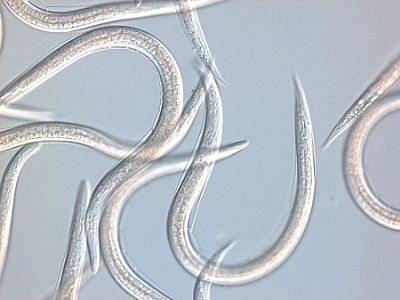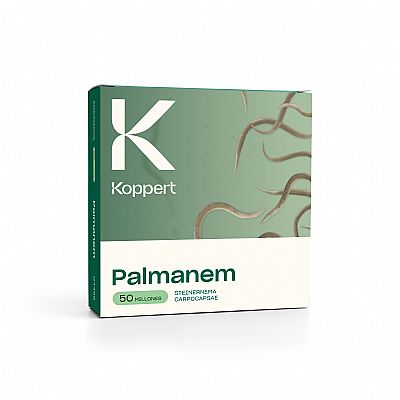PALMANEM / Steinernema carpocapsae
Entomopathogenic nematodes
Target
Use Palmanem for biological control of larvae of larvae of the families of Noctuidae, Pyralidae, Tipulidae (crane flies) and the great pine weevil (Hylobius abietis) and Capnodis tenebrionis. Larvae of various other Coleoptera (beetles) and Orthopthera (e.g. mole crickets).
Packing
Each box contains larvae (third stage) in gel
-
Standard Palmanem: 2 bags in a box Each bag contains 25 million larvae
-
Large Palmanem: 2 bags in a box Each bag contains 250 million larvae
Dosage PALMANEM
|
Package
|
Rate | Treated palm trees per pack** | Spray volume per tree | Frequency | Remarks |
| 50 million |
1 pack per 25 - 50 lt
spray solution*
|
1 - 10 trees | 5 - 50 lt / tree |
Apply in autumn
(Oct – Nov),
repeat after 2 weeks.
Apply in spring (April-May),
repeat after 45 - 60 days for Rhynchophorus ferrugineus, after 2 weeks Paysandisia archon
|
Apply when temperatures *** are between 14 and 35oC.
Repeat applications with conventionally allowed insecticides
if the internal temperature of the palm is> 35°C
|
| 500 million |
1 pack per 250 - 500 lt
spray solution*
|
10 - 100 trees | 5 - 50 lt / tree |
Application rates
|
Tree type
|
Species
|
Application
method
|
Nursery
|
small <1.5 m tree
|
Average high 1,5 – 4 m
|
|
Ornamental city trees
|
Washingtonia, Trachycarpus,
Phoenix canariensis, Chamaerops humilis
|
drench the entire crown of the tree
|
1-5 lt / tree
|
5-10 lt / tree
|
10-20 lt / tree
|
|
Date palm
|
Phoenix dactilyfera
|
Drench the whole tree, from top
to bottom - spray in holes and mines
|
1-5 lt / tree
|
5-10 lt / tree
|
10-20 lt / tree
|
* 1 lt of solution corresponds to 1 million nematodes.
** depending on the plant high
*** internal palm tree temperature.
The information given below is merely indicative. Tailored advice can be provided if information is available on the local factors that need to be taken into account, such as the crop, the climate conditions and the level of infestation. For the correct approach, please consult a specialist of our company.
How Palmanem works
After application, the nematodes actively search for their prey and penetrate them. The nematodes feed on the contents of the prey, excreting specific bacteria from their digestive tracts as they do so. These bacteria convert host tissue into products that the nematodes can easily ingest. The larvae die within a few days.
Application Palmanem
Preparation of the solution:
-
Half an hour before preparing the product, remove the pack from the refrigerator and let it come up to room temperature (20°C)
-
Break the contents of the sachet (250 million Steinernema carpocapsae) into smaller pieces. Use the entire pack and place the smaller pieces in a bucket containing five litres of water (at 15 to 20°C) 3
-
Leave the bucket with the solution to stand for five minutes
-
Then stir the solution until all the lumps have disappeared before transferring it to the spray tank
-
Use the spray solution straight away
Application and dosage:
-
With a watering- can, sprinkler system, backpack spray unit or vehicle-mounted spray unit
-
To avoid blockage, all filters should be removed
-
Use a maximum pressure of 12 bar on spraying boom or pistol
-
The spray nozzle opening should be at least 0.5 mm (500 microns)
-
Continuous mixing should take place to prevent nematodes sinking to the bottom of the spray tank
-
Apply the solution to the whole of the crown and the first metre of the trunk ensuring that the solution penetrates well into the palm tree.
-
Application rates The information given below is merely indicative. Tailored advice requires detailed information on local factors, such as the crop itself, climate conditions and the level of infestation. To ensure a correct approach, please consult a Koppert specialist or a recognized distributor of Koppert products.
Best working conditions for Palmanem
-
The moisture content of the soil must be high
-
Temperature between 14 and 33°C
-
Nematodes are susceptible to ultraviolet light (UV): do not use them in direct sunlight
-
Leaf applications should only be carried out in the evening to minimise the influence of UV light and to maximise moisture availability for the nematodes
Handling
Biological beneficials have a very short life expectancy and therefore need to be introduced into the crop as soon as possible after receipt. Failure to do so can have a negative impact on their quality. In case you do need to store Palmanem, please follow the instructions below.
Storage
-
Immediately upon receipt, take the box out of the shipment parcel.
-
Refrigerate at a temperature between 2°C and 6°C (35-43°F) in a ventilated refrigerator/cold room.
-
Keep away from direct sunlight.
-
Observe the use-by date shown on the box.
Pesticides can have (in)direct effects on beneficials. Check here




 HellasSITES
HellasSITES